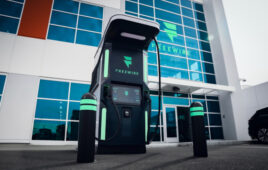It’s estimated that there are over 3 million EVs on the road in the United States, driving between home and work every day. The current utility-based EV charging paradigm is based on using home-based bidirectional EV chargers to support the electric grid in late afternoons and evenings.
Alas, this vehicle-to-grid (V2G) setup is an inefficient and expensive way to support the electric grid. Current V2G business models benefit utilities, penalize EV owners and increase customer electricity costs.

Rendering of a 2024 Chevrolet Silverado EV with Ultium Home offerings, including a bidirectional charger.
The reason current V2G models don’t leverage EV batteries is simple: utilities don’t want to pay vehicle owners for the true value of energy and power supplied to the grid by EVs.
To understand why, you have to dig into the numbers. As a ballpark estimate, the lifetime value of energy delivered from a typical EV battery is $0.28/kWh (assuming a 100,000-mile warranty, a 100-kWh battery, replacement costs at $100/kWh per battery, and average mileage of 2.8 miles per kWh), plus the bidirectional charger and its associated components, which can easily cost another $10,000.
Basically, every kilowatt-hour delivered by the battery to the grid through V2G costs the EV owner $0.28, not including the cost of the additional interconnection equipment. As a committed EV owner (I’m on my third), I am not so enamored with my utility that I will let it use my battery for less than it’s worth. For V2G to make sense in this example, utilities must compensate EV owners for much more than $0.28/kWh.
EV owners want to use the energy in their EV battery to make money. Examples of money-making situations for EV owners include offsetting evening peak energy costs of $0.59/kWh on California’s current EV2 rate or using that EV energy to sell power to the utility at $2.70/kWh under the new NEM3 rates during peak hours (6-8 p.m. in September).
A much better alternative than low-compensation V2G is the vehicle to home (V2H) setup. With V2H, EV owners can use their vehicle’s battery to power their home to offset peak electricity costs at night when the grid is active, with a bonus of backup power during blackouts. But V2H conflicts with nighttime charging of an EV. An EV battery can’t be charged from the grid at night at the same time as powering the home.
I believe charging vehicles at night when there is no solar contribution is backwards and expensive since we are not using inexpensive daytime-generated solar energy. Instead, EVs need to be charged at workplaces during the day when it’s sunny.
Unfortunately, practical V2H applications are actively discouraged by utilities. The reason is that widespread V2H — designed in a way that saves money for customers — reduces utility profits. Lest there be any doubts about utility efforts to maximize profits at the expense of ratepayers, utilities are working to overturn every single “behind the meter” solar and storage policy in California — including net metering, labor policies, battery incentives, simple metering requirements, community solar, multi-family (often low and middle income) solar and prompt interconnections.
The V2H paradigm needs to be flipped to benefit EV owners, not utilities.
The ideal way to harvest local daytime solar energy is to charge EVs from solar panels co-located with company-sited Level 2 EV chargers. Employees drive their EVs to work, plug in to top off their battery, then drive home and plug in their fully charged EV. Public parking lots, schools and shopping centers can also be equipped with Level 2 chargers, saving expensive Level 3 fast DC chargers for highway and roadside charging.
Let’s take the V2H concept to its logical conclusion: using fully charged EV batteries in garages and driveways to power homes in the evening when duck curve demand is at its peak. Of course, a properly designed V2H system will be compliant with utility and safety regulations. Moreover, when the energy in the car battery is derived from inexpensive rooftop commercial or residential rooftop solar, avoiding peak electricity costs of $0.59/kWh is twice as valuable compared to the $0.28/kWh degradation cost of the battery.
I find it puzzling as to why EV manufacturers are not more supportive of V2H. Granted, there will be faster battery degradation when used in this stationary mode, but manufacturers can adjust their warranties accordingly. That expensive car battery can provide drivers with a significant additional value stream when used at home — making EVs more affordable.
An even bigger value accrues to ratepayers at large. There is no need to build trillions of dollars of transmission infrastructure for widespread electrification if we enable EVs to soak up cheap daytime solar power and discharge at night. EV batteries used in this way will flatten the duck curve both by absorbing excess daytime solar at midday and reducing evening home consumption.
By encouraging local commercial, community and residential solar, energy harvested from the sun is easily transported over existing roads with V2H — steering around the utility monopoly on wires. No need to wait decades for underground long distance transmission lines, remote solar farms or expensive grid-scale batteries. Most importantly, no need for ratepayers to pay for these exorbitant utility investments that drive our electricity rates through the roof.
We need to reverse the current EV charging paradigm of expensive roadside “filling station” EV charging and utility-constrained daytime solar charging. Vehicle manufacturers should be supportive of V2H so they can sell more cars. Utilities should be candid about the true costs to EV owners of their V2G pilot programs, and utilities should be regulated instead of coddled. And homeowners should buy EVs that fully support V2H functionality. It will save everyone money. Except, perhaps, utility stockholders.






Barry Cinnamon is the most insightful, cogent authority in green energy I know.
“… steering around the utility monopoly on wires…”
to me, says it all. PG&E is a $1B+/year company. When we talk those kind of numbers, it becomes a private business willing to stomp out any competitive ideas, with nothing “public” in a “publicly-owned utility”. Why else would they have lobbyists?